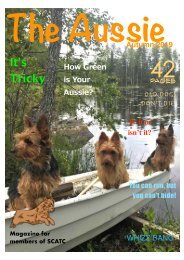The Aussie - Spring 2019
Magazine only for Members of the Southern Counties Australian Terrier Club
Magazine only for Members of the Southern Counties Australian Terrier Club
You also want an ePaper? Increase the reach of your titles
YUMPU automatically turns print PDFs into web optimized ePapers that Google loves.
Omega-3<br />
By ensuring your dog’s intake of<br />
Omega -3 takes place you are<br />
helping to balance and regulate<br />
their immune system, reduce<br />
excessive inflamma?on that creates<br />
allergy symptoms, joint pains and<br />
many other chronic condi?ons.<br />
<strong>The</strong>re is also recent evidence to<br />
suggest Omega-3 helps turn round<br />
cardiovascular disorders, boost<br />
cogni?ve func?on and overall<br />
re?nol health.<br />
It is used to reduce the symptoms<br />
of osteoarthri?s and ageing both<br />
mentally and physically.<br />
How can we get this wonder<br />
addiJve into our dog’s diet?<br />
Foods that are rich in omega-3 are<br />
fish – marine sources like herring,<br />
sardines, mackerel, anchovies,<br />
salmon. Quality dog foods, will<br />
source these products form non<br />
contaminated sources. Natural<br />
sources are beUer than<br />
supplements. <strong>The</strong> recommended<br />
dose is 100-150mg of EPA and DHA<br />
(2 components of Omega-3) per 5<br />
kilos of body weight.<br />
A fragile addiJve<br />
Care has to be taken by the food<br />
manufacturer and addi?ve<br />
suppliers with omega-3. It is<br />
inherently very delicate and highly<br />
suscep?ble to oxida?ve damage.<br />
Once this happens the omega-3 can do more harm than good.<br />
Bearing in mind the delicate nature of omega-3, it highlights the<br />
fact that commercial dog food claiming to be packed with<br />
omega- 3 may not be packed with the right quality. It is highly<br />
suscep?ble to heat damage, which many dogs’ food produc?on<br />
entails.<br />
<strong>The</strong> solu?on is to add Vitamin E that is fat soluble, it will help<br />
with the oxidisa?on issue. Always check the ingredients when<br />
you buy your dog’s food. Try not to just think of the price tag.<br />
Other sources of fat<br />
Recently there have been some new trends. <strong>The</strong> first is organic,<br />
raw unpasteurised buUer. T contains a healthy ra?o of omega-6<br />
and omega-3. Plus it contains Butyric acid, which has shown<br />
great promise in studies to reduce diabetes, inflamma?on,<br />
cancer and diges?on issues.<br />
Coconut oil is another on trend fat. It is mostly saturated.<br />
Amongst the cons?tuents of coconut oil is something called<br />
caprylic acid. This is known for its ability to feed yeast and<br />
studies show that it has posi?ve results on diabetes.<br />
Dogs do seem to enjoy fish as the shopping<br />
bag with fish shows. It certainly has captured<br />
these dogs aUen?on.<br />
If you decide to use coconut oil in your dog’s diet, the<br />
recommended dosage is 1 teaspoon for every 5kg of<br />
bodyweight.<br />
All these fats are considered to be brain food as well.<br />
<strong>The</strong>re are innumerable studies valida?ng this theory.<br />
<strong>The</strong> advice that seems to be related to all the dogs food<br />
these days is check out the ingredients and be aware of<br />
the diet and quan?ty that your dog should have. By doing<br />
this you can provide a balanced diet.<br />
So next ?me you think – fats no way – think again – they<br />
could have an important part to play in your dog’s health<br />
and well being.









